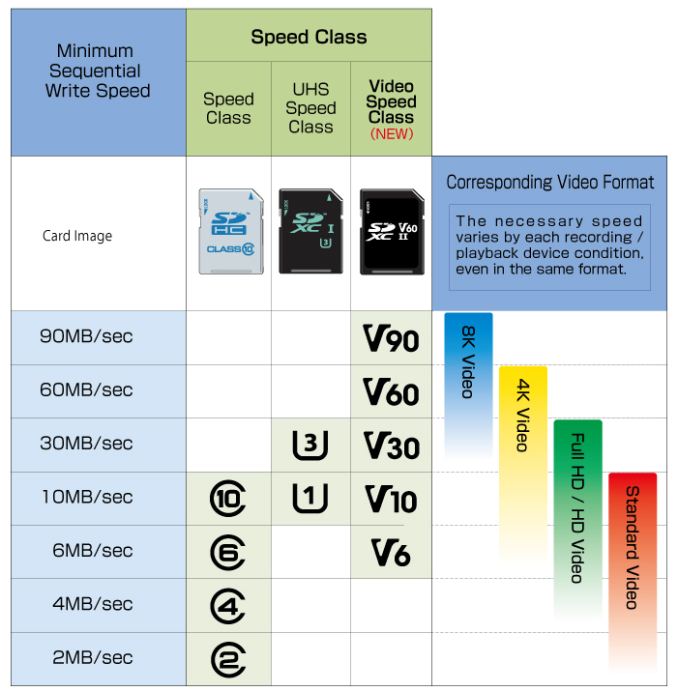Edge Memory Announces Video Speed Class SD Cards`
by Ganesh T S on January 23, 2017 10:00 AM EST- Posted in
- Trade Shows
- Flash Drive
- Mushkin
- SD cards
- CES 2017
- Edge Memory

As part of our CES 2017 vendor visits, we talked to Mushkin and Edge Memory about their upcoming products. For those unaware, both Mushkin and Edge Memory are brands of Avant Technology. Both brands share a number of products, with Edge Memory focusing more on the enterprise and SMB / SME market segment. Mushkin's CES 2017 announcements have already been covered last week. The external direct-attached storage products are being currently prepared for sale under the Edge Memory brand.
The most interesting of all the new products are the VSC SD cards (Video Speed Class). While the SD Association recently announced the A1 application-performance class for use in general computing environments, the Video Speed Class rating is meant for cards used in video recording environments - including, but not restricted to, products like action cameras, dashcams, IP cameras, and the like. The key here is that the card must be able to guarantee a minimum sustained write speed to qualify for one of the VSC classes.
Image Courtesy: SD Association
In Spring 2017, Edge Memory plans to launch a suite of SDXC (16-256 GB) and micro-SDXC (16 - 128 GB) cards with operating temperature range between -25C and 85C. This makes them suitable for industrial use-cases also.
The cards are expected to come in a range of VSC ratings. Claimed performance numbers indicate 225 MBps reads and 195 MBps writes. However, what really matters is the VSC rating that reflects the sustained write speeds that decide the suitability of these cards for a particular application.
Edge Memory also announced a number of other products - a bus-powered USB 3.0 enclosure for M.2 SATA SSDs (using ASMedia ASM1153E for the micro-B version, and the ASM1351/1542 for the Type-C version), a USB OTG-compatible flash drive with both Type-C and Type-A interfaces, and new members in the diskGO Secure Ultra USB Storage lineup which has a keypad / physical PIN support to enable hardware encryption of the contents.
Avant Technologies seems to be sharing the required R&D for flash-based product lines between Mushkin and Edge Memory. In bringing the products to the market, it is clear that Mushkin is targeting the average consumer / gamer, while Edge Memory targets business and industrial use-cases. The DAS ineup from Edge Memory for the first half of 2017 appears to tap into that market quite well.


















16 Comments
View All Comments
ganeshts - Monday, January 23, 2017 - link
Even 4K videos compressed with H.264 can make do with around 100 Mbps (~12 MBps) bitrate. HEVC should be able to deliver more efficiency. Quadruple that for 8K videos.90 MBps is more than enough (translates to 720 Mbps) for compressed video. If you are recording RAW, you need CFast 2.0 or a proper SATA SSD (or, even NVMe PCIe drives)
Guspaz - Tuesday, January 24, 2017 - link
Professional video recorders typically use Apple ProRes or DNxHD (DNxHR for above 1080p) rather than h.264 or HEVC. They're both intra-frame-only codecs, meaning every frame is compressed independently, sort of like MJPEG, so they have massive bitrates.ProRes 422 HQ is 176 Mbps for 1080p24, so 4K24 would be 704 Mbps, or 88MB/s.
So, yeah, 90 MB/s is just barely enough for 4K, assuming you don't want to use more than ~24 FPS, and assuming you don't want to use ProRes 4444 or 4444 XQ. But at that point, you'll probably want to record to an SSD rather than SD.
lioncat55 - Monday, January 23, 2017 - link
It really depends on the bit rate and recording format. GoPros use around 60Mbit/s for their 4K recording while a Canon C300 recording 4k RAW can use over 200Mbyte/s.DanNeely - Monday, January 23, 2017 - link
Thanks. With that as context, and assuming Go Pro's 4k represents the approximate floor for mainstream 4k recording; its bitrate lines up with the bottom end of the tail of the 4k bar while leaving plenty of headroom for higher quality options above it. Recording RAW 4k blows the top; but recording RAW video's a pro feature while SDcards have always been aimed at the cheaper mainstream consumer market.Guspaz - Tuesday, January 24, 2017 - link
While it's true that most pro gear will record directly to SSDs (typically in at least a custom enclosure, if not an entirely custom SSD), lower-end pro recorders (like in the $500-1000 range) sometimes record to SD, as do some ENG cameras.SharpEars - Tuesday, January 24, 2017 - link
Whoa, a whole 90 MB/s, whoop-d-&#$^&-do!